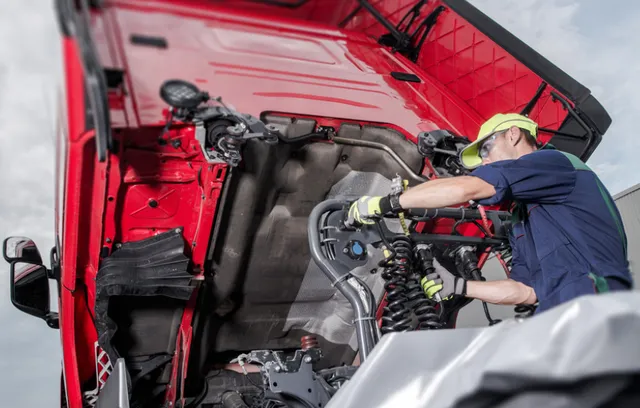Getting the most miles out of your heavy-duty pickup or commercial truck tires requires diligent maintenance. The critical practice is regular tire rotation. Truck rotation involves moving the tires to new positions on the wheels to distribute wear evenly across the tread. With truck tires carrying heavy loads, they wear unevenly if not rotated. Rotating every 3,000 to 8,000 miles extends the usable tread life substantially. This saves money on frequent tire replacements. Truck tires also need specific rotation patterns between steer, drive, and trailer positions. Read on for a complete guide on when and how to rotate truck tires properly. Keeping the proper truck tire rotation schedule will maximize your tire investment while enhancing safety and performance.
What is a Tire Rotation?
Truck rotation is the regular process of moving truck tires to different wheel positions to promote even wear. Like all vehicles, truck tires wear at uneven rates depending on their work on the truck. The front wheels and drive wheels tend to wear faster than others. By rotating the tires, wear can be distributed more evenly across the tires. This extends the life of the tires, improves traction and handling, and saves on tire costs over time.
Truck rotation involves moving the steering, drive, and trailer tires to new locations at regular intervals. Following the recommended truck tire rotation patterns and schedules helps maximize tire durability for heavy-duty trucks.
What Does Tire Rotation Do?
- Promotes even wear – Truck tires wear unevenly if left in one spot. Rotation spreads outwear over more tread.
- Extends tire life – Evening out tread wear allows truck tires to last longer before needing replacement.
- Maintains traction – Rotating preserves tread depth for continuous grip and braking traction.
- Saves money – Getting more miles out of truck tires before needing new ones saves on tire costs.
- Enhances steering and handling – Uneven wear can pull the truck to one side. Rotation helps steering precision.
Which Rules Could Describe the Rotation?
There are a few fundamental rules of tire rotation that apply specifically to the tire rack:
- Rotate every 5,000-8,000 miles – This is the typical interval for truck tire rotations to maintain even wear.
- Follow particular dual wheel rotation patterns – Dual wheel trucks need specific rotation sequences to shift inner and outer duals.
- Rotate front steer tires to rear – Moving steering tires to the rear evens out front vs. rear wear.
- Don’t rotate side to side on single wheels – Truck tires should go straight back, not side to side, except for dual rear wheels.
- Watch for uneven wear – If wear develops, rotate more frequently or inspect for suspension issues.
What is the Proper Tire Rotation Pattern?
The most common truck tire rotation patterns are:
Single Rear Wheels
For trucks with single rear wheels:
- Front tires go straight back to the rear
- The rear tires move up to the front
- Tires do not move left to right
Dual Rear Wheels
For dual rear-wheel trucks:
- Front single tires go to the rear
- Rear inner duals move to the outer dual position
- Rear outer duals move to the internal position
Tractor Trailers
For tractor-trailer combinations:
- Rotate the tractor’s front steering tires to the rear trailer axle
- Rotate trailer axle tires to tractor steering
- Rotate tractor drive tires front to back
All-Wheel Drive Trucks
For AWD trucks:
- Rotate tires in clockwise pattern, keeping them on the same axles
- Rear tires can also go directly to the front and vice versa
How Much Does a Tire Rotation Cost?
Average costs for truck tire rotation range from $25 to $50 per axle:
- Light-duty pickup truck: $25-$35 per axle
- Heavy-duty pickup: $30-$45 per axle
- Medium-duty truck: $40-$50 per axle
- Tractor-trailer/18-wheeler: $50-$75+ per axle
Shops may charge extra for duallies. Prices also depend on other bundled services, like brake inspections or alignment.
Fleet discount deals and tire shop packaged bundles can reduce truck rotation costs. DIY rotation may save further but requires equipment and capability.
How Long Does a Tire Rotation Take?
Rotate time varies by truck size, but expect:
- Light truck/SUV: 45 min – 1 hour
- Heavy duty pickup: 1 – 1.5 hours
- Medium truck: 1.5 – 2 hours
- Tractor-trailer: 2+ hours
The process involves:
- Lifting and removing wheels
- Moving tires to new positions
- Re-installing wheels
- Torque-checking lug nuts
- Inspecting components
Larger trucks with double wheels naturally take longer. Combination rigs require rotating tires both tractor and trailer tires.
How Many Miles for Tire Rotations?
Light trucks need rotation every 5,000-8,000 miles. Heavy-duty trucks and tractors require rotation more often:
- Pickup trucks: Every 5,000-7,000 miles
- Heavy duty pickups: Every 3,000-5,000 miles
- Medium-duty trucks: Every 2,000-4,000 miles
- Tractor trailers: Every 2,000-3,000 miles
Frequent hauling, towing, and aggressive driving accelerate wear. Inspect tires before intervals for uneven wear and rotate as needed.
How Long Does an Oil Change and Tire Rotation Take for Trucks?
When paired together, expect a truck oil change and tire rotation to take:
- Light truck/SUV: 1 – 1.5 hours
- Heavy duty pickup: 1.5 – 2 hours
- Medium truck: 2 – 2.5 hours
- Tractor-trailer: 2.5+ hours
Oil change steps add:
- Drain and replace oil: 15-20 minutes
- Change oil filter: 10-15 minutes
- Check other fluids: 5-10 minutes
Doing both services together still offers convenience versus two visits. Some shops offer package deals on truck oil change and rotation bundles.
Truck Tire Rotation Intervals
Proper truck tire rotation intervals depend on truck class, use, and operating conditions.
Pickup Trucks
- Light duty pickup: Every 5,000-7,500 miles
- Heavy duty pickup: Every 3,000-5,000 miles
- Towing/hauling: Shorten interval
Medium-Duty Trucks
- Box truck, dump truck, etc.: Every 3,000-4,000 miles
- Severe service: Every 1,500-3,000 miles
Tractor Trailers
- Line haul long haul: Every 2,500-3,000 miles
- Regional haul: Every 1,500-2,500 miles
- Specialized hauling: Frequent rotation
Off-Road Service
- Pickup, dump, vocational trucks: Every 1,500-3,000 miles
- Watch tires closely for damage during rotations
Truck Tire Rotation Patterns
Trucks use specialized rotation patterns for even wear.
For Pickup Trucks
- Use a forward cross X pattern
- Front to rear, do not rotate side to side
For Dual Rear Wheel Trucks
- Rotate the front tires to the rear
- Swap inner and outer rear duals
For Tractor Trailers
- Rotate tractor front to trailer rear
- Rotate tractor drives front to back
- Rotate trailer tires forward to the tractor
For Truck with Super Singles
- Rotate as pairs, keeping to the same axles
- Fronts go to the end; rears go to the front
Check OEM recommendations for your exact truck configuration and used tires. Be careful not to introduce wear bias.
Benefits of Rotating Truck Tires
Choose Best Truck Repair Shop For Your Truck Today!
- Affordable
- Quick Fix
- Boost Truck Performance

Staying on top of truck tire rotation rules provides significant advantages:
Longer Tire Life
Even tread wear lets truck tires last for the miles they are designed for. Proper rotation extends tire life by 10-20%.
Improved Traction and Control
Full tread depth gives trucks maximum grip for acceleration, cornering, and stopping traction. This enhances control and stability.
Increased Fuel Economy
Evenly worn tires have lower rolling resistance, allowing trucks to roll more easily. This boosts fuel efficiency.
Better Ride Comfort
Smooth tread without irregular wear absorbs vibrations better for a more comfortable, stable ride.
Enhanced Safety
Uniform tread depth equals consistent grip. This provides the best braking, cornering, wet weather and stopping power for maximum safety.
When to Stop Rotating Truck Tires
While tire rotation extends useful tread life, truck tires eventually wear out and require replacement. Watch for these indicators:
Minimum Tread Depth Reached
Trucks must have at least 4/32″ minimum front tread depth and 2/32″ rear by law. Replace tires before reaching these limits.
Tread Wear Bars Visible
If tread wear bars appear across two or more grooves around the circumference, the tire is worn out.
Ongoing Uneven Wear
If a tire shows uneven wear across the tread despite rotation, it likely has an internal defect. Replace it.
Damage or Cracking
Look for cracks, cuts, bulges, or damage during rotation. Replace any deteriorated tires immediately.
Tires Over 6 Years Old
Regardless of tread life, replace truck tires over six years old. Rubber compounds degrade over time.
Watch for these signs and pull worn tires out of service from tire shops near me. Attempting to rotate tires in poor condition wastes effort and creates risk.
Tips for Effective Truck Tire Rotation
Follow these tips to make the most of your truck tire rotations:
- Stay on schedule with courses based on mileage
- Inspect tires thoroughly each spin for wear and damage
- Follow OEM rotation patterns exactly
- Use chalk or crayon to mark duals when swapping
- Re-torque wheels and check inflation pressure after rotation
- Reset tire pressure monitors to new locations after rotating
- Pair rotation with oil changes, brake service, etc., to save time
- Ask for a printout showing rotation service for your records
- Ensure technicians are experienced with large truck tire service
Summary
Trucks need regular tire rotation, like any vehicle, to maximize tire life, safety, and performance. But trucks put more stress on tires and require specialized rotation patterns. Follow OEM and tire manufacturer guidelines for your exact truck configuration. Rotate at more frequent intervals based on miles and rig use. Combine rotations with alignments, brake service, and oil changes to get the most value from this vital maintenance. Your heavy-duty work trucks will keep rolling safely for the long haul with proper tire rotation contact B&S Truck Repair.
FAQs on Truck Tire Rotation
What is the best truck tire rotation sequence?
Follow your truck maker’s rotation pattern recommendations. General guidelines are to rotate front to rear and swap inner-outer duals.
Should truck tires be rotated from side to side?
No. Truck tires should move straight forward or back. Exceptions are some dual-wheel configurations.
How often should I rotate truck tires?
Every 5,000-8,000 miles for light trucks. Every 2,000-4,000 miles for heavy-duty trucks, depending on use.
Do trailer tires need rotation, too?
Yes, rotate the trailer and tractor tires to distribute wear uniformly.
Can I rotate just the front or just the rear truck tires?
It’s ideal to rotate all tires, but rotating only rears or only fronts does offer partial benefit.
What is the front-to-back rotation pattern?
Front tires go directly back to the rear axle. The rear tires move up to the front steering axle.
Should I get an alignment with each tire rotation?
If truck alignment is still within spec, periodic rotation alone can be sufficient between alignments.

